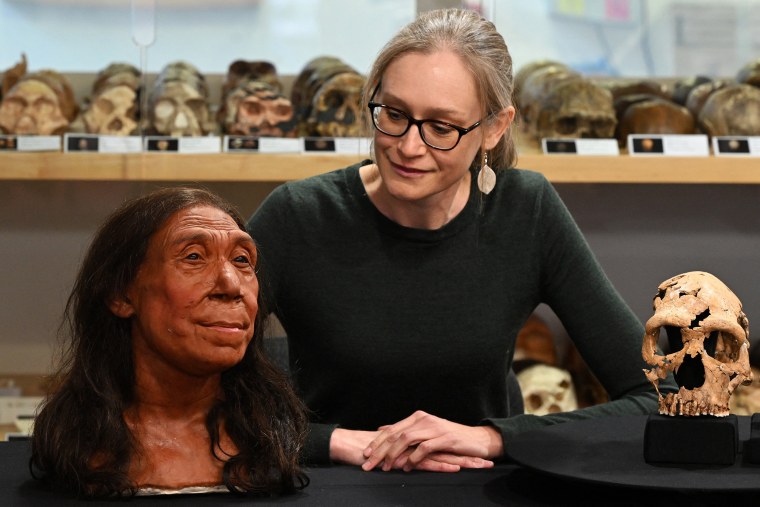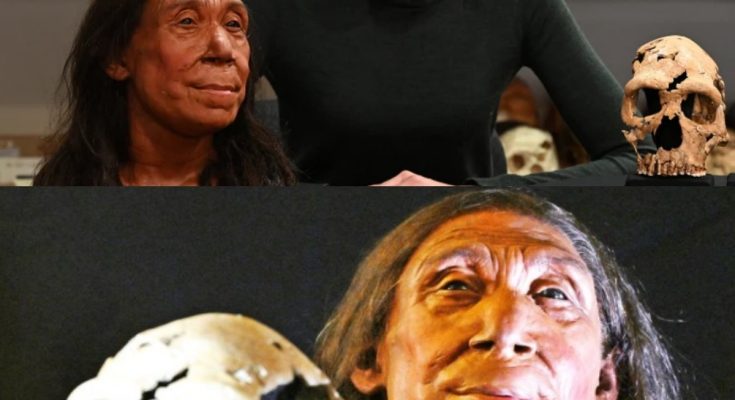The unveiling of a 75,000-year-old female Neanderthal’s reconstructed face marks a significant breakthrough in our understanding of our closest extinct relatives. This discovery, emerging from the depths of Shanidar Cave in Iraqi Kurdistan, is featured in the new documentary produced by BBC Studios Science Unit to be released on Netflix.

The documentary, “Secrets of the Neanderthals” follows the team led by the universities of Cambridge and Liverpool John Moores as they return to Shanidar Cave to continue excavations.

View of the entrance to Shanidar Cave, within the Zagros Mountains in the Kurdistan region in northern Iraq. (Prof Graeme Barker/University of Cambridge)
Archaeological Breakthrough at Shanidar Cave
In 2018, a team led by the University of Cambridge made a groundbreaking discovery inside Shanidar Cave—a site previously famed for its series of Neanderthal remains. This particular cave had not yielded new Neanderthal discoveries for over fifty years, making the unearthing of what was named Shanidar Z particularly significant. The excavation revealed not just any Neanderthal, but one whose preserved state provides a unique window into the life and times of these ancient beings.
The team meticulously extracted the remains, encapsulated in the cave’s compacted sediments, and transported them back to Cambridge for detailed analysis. The skull, once flattened and now meticulously reconstructed, offers a new face to a species often misrepresented in historical narratives.
Did The Neanderthals of Shanidar Cave Really Bury their Dead? Prehistoric Neanderthal and Human Chefs Cooked Up Tasty Dishes

The skull of Shanidar Z, which has been reconstructed in the lab at the University of Cambridge. (BBC Studios/Jamie Simonds/University of Cambridge)
The Reconstruction Process: Techniques and Discoveries
The reconstruction of Shanidar Z’s face was a painstaking process, where over 200 pieces of her skull were pieced together by Dr. Lucía López-Polín, the lead conservator. This was followed by the use of advanced forensic and archaeological techniques to model her facial features, supervised by paleoartists Adrie and Alfons Kennis. The result is a face that challenges the rugged, harsh depictions often associated with Neanderthals, showcasing softer, more human-like features that hint at a close evolutionary relationship with modern humans.
Dr. Emma Pomeroy, a paleoanthropologist involved in the project, noted, “The recreated face suggests that the differences between Neanderthals and modern humans were not so stark. This finding supports theories suggesting interbreeding between our species.”
Insights into Neanderthal Life and Culture
The ongoing studies of Shanidar Cave offer more than just physical reconstructions; they provide insight into the cultural practices of Neanderthals. The cave was a site of repeated burials, with evidence suggesting a sophisticated approach to death, including potential ritualistic behavior—a trait once thought to be exclusive to modern humans.
Professor Graeme Barker, from Cambridge’s McDonald Institute for Archaeological Research, emphasized the importance of these findings: “Our discoveries show that Neanderthals may have been contemplating death and its aftermath in ways not dissimilar to modern humans.”
The Implications of Shanidar Z’s Discovery
Shanidar Z is believed to have been an older female, possibly in her mid-forties, making her one of the eldest Neanderthals discovered in this region. Her discovery alongside evidence of intentional burial deepens our understanding of Neanderthal social structures and their capacity for empathy and community.
Moreover, the findings challenge the notion that Neanderthals were simple, brutish creatures. Instead, they present a picture of a complex society capable of emotional depth and sophisticated thought—qualities that redefine our perceptions of this ancient species.

The recreated head of Shanidar Z, made by the Kennis brothers for the Netflix documentary ‘Secrets of the Neanderthals’ based on 3D scans of the reconstructed skull. (BBC Studios/Jamie Simonds/University of Cambridge)
Future Directions and Continued Research
The work at Shanidar Cave continues to yield significant insights into the lives of Neanderthals and their interactions with early modern humans. As researchers delve deeper into the cave’s layers, each discovery adds a piece to the puzzle of human evolution, highlighting the intricate tapestry of ancestry we share with Neanderthals.
This research not only enriches our understanding of the past but also informs how we think about our own origins and the journey that humanity has undertaken over the millennia.
This article is based on the article, ‘Revealed: face of 75,000-year-old female Neanderthal from cave where species buried their dead’ published by the University of Cambridge.
Top image: Dr Emma Pomeroy (University of Cambridge) with the skull of Shanidar Z in the Henry Wellcome Building in Cambridge, home of the University’s Leverhulme Centre for Human Evolutionary Studies. Source: BBC Studios/Jamie Simonds/University of Cambridge




